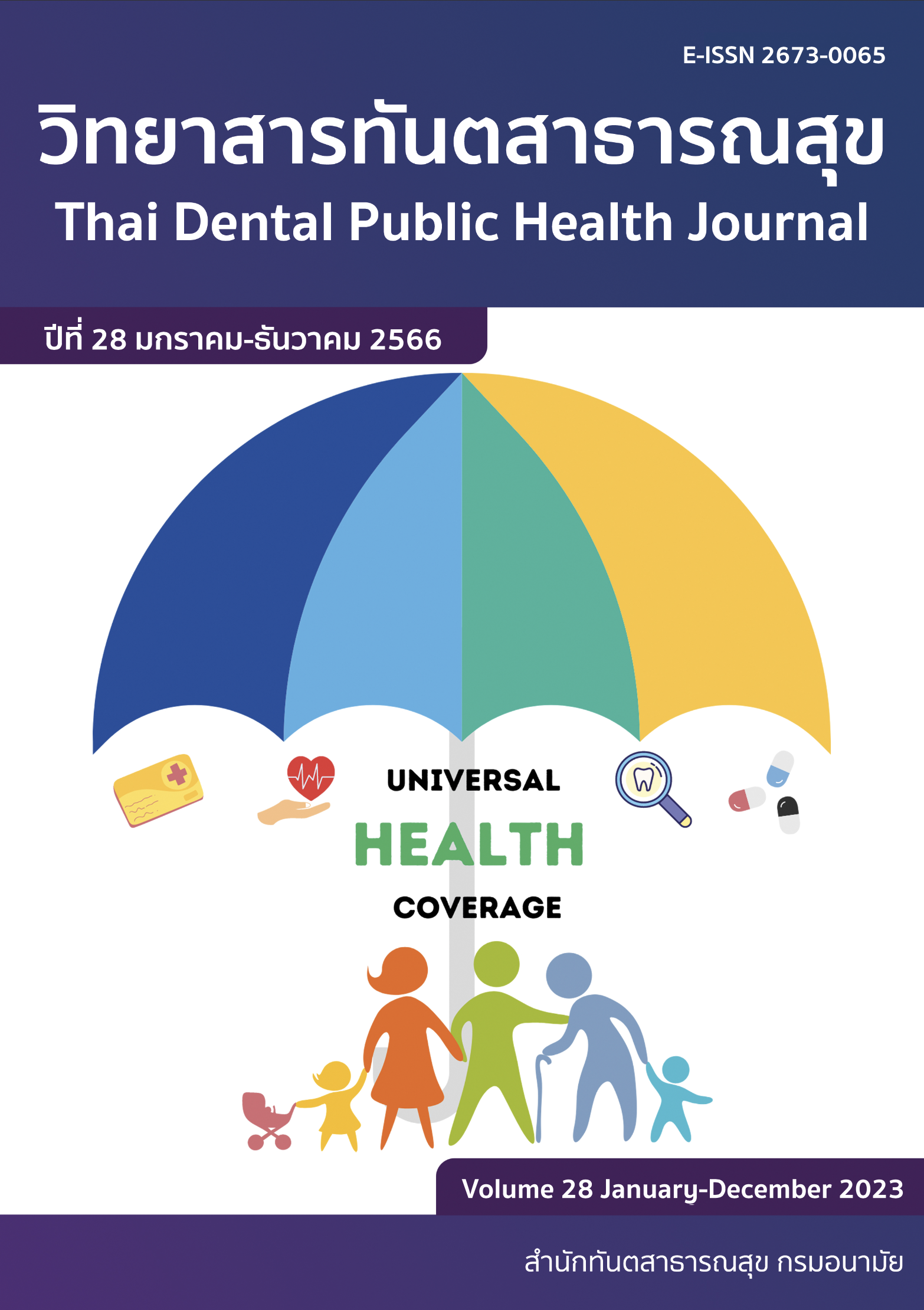Factors related to dental caries among prisoners in an open correctional institution in Southern Thailand
Main Article Content
Abstract
This cross-sectional study aimed to determine the prevalence and correlation of dental caries among prisoners in an open correctional institution in Southern Thailand. The data were collected in March 2021. The population was 134. They were interviewed and oral health examined to collect general characteristics, oral health behaviors, and oral health status by an experienced and calibrated hospital dentist. Data analysis was performed with descriptive statistics. The association between variables was determined by the chi-square test. The degree of association between dental caries and various variables was determined by multivariable logistic regression. The result showed that DMFT was 11.0±5.07. The analysis revealed that dental caries among prisoners were significantly related to a high plaque score (OR = 2.58; 95% CI = 1.16–5.72; p<0.05). Our data suggest that the prevalence of dental caries among prisoners is high. A high plaque score is significantly associated with dental caries among prisoners. Dentists should pay attention to oral health promotion and prevention programs in prison that emphasize dental plaque control by tooth brushing with fluoride toothpaste.
Downloads
Article Details

This work is licensed under a Creative Commons Attribution-NonCommercial-NoDerivatives 4.0 International License.
References
World Health Organization. Data and statistics: Prisons and health. [online] 2020 [cited 2022 Apr 22]; Available from: URL:https://www.euro.who.int/en/health-topics/health-determinants/prisons-and-health/data-and-statistics
Walmsley R. Key points. In World prison population list. 12th ed. London: Institute for Criminal Policy Research; 2018. p. 2.
Department of Corrections. Statistics report on prisoners. [online] 2022 [cited 2022 Apr 22]; Available from: URL:http://www.correct. go.th/rt103pdf/ (in Thai)
Tanongsaksakul J, Detsomboonrat P. Oral health status of male prisoners in the corrective department at Pathumthani Province. J Dent Assoc Thai 2008; 58: 255-62. (in Thai)
Rungratsametawemana U. Oral health status of delinquent youth at Ubonratchatani detention centre, Thailand. Th Dent PH J 2014; 19: 21-33. (in Thai)
Bureau of Dental Health. The 8th national oral health survey 2017 of Thailand. Bangkok: Department of Health; 2018. (in Thai)
Wei SHY, Lang NP. Periodontal epidemiological indices for children and adolescents: II. Evaluation of oral hygiene; III. Clinical applications. Pediatr Dent 1982; 4(1): 64-73.
World Health Organization. Oral health surveys basic methods. Monts: Présence Graphique; 2013.
Freeman R, Richards D. Factors associated with accessing prison dental services in Scotland: a cross-sectional study. Dent J 2019; 7(1): 1-12. doi:10.3390/dj7010012
Valm AM. The structure of dental plaque microbial communities in the transition from health to dental caries and periodontal disease. J Mol Biol 2019; 431(16): 2957-69. doi:10.1016/j.jmb.2019.05.016
Nobile CGA, Fortunato L, Pavia M, Angelillo IF. Oral health status of male prisoners in Italy. Int Dent J 2007; 57(1): 27-35. doi:10.1111/j.1875-595X.2007.tb00115.x
Ellwood RP, Davies GM, Worthington HV, Blinkhorn AS, Taylor GO, Davies RM. Relationship between area deprivation and the anticaries benefit of an oral health programme providing free fluoride toothpaste to young children. Community Dent Oral Epidemiol 2004; 32(3): 159-65. doi:10.1111/j.1600-0528.2004.00150.x
Amaechi BT, AbdulAzees PA, Alshareif DO, Shehata MA, Lima PPDCS, Abdollahi A, et al. Comparative efficacy of a hydroxyapatite and a fluoride toothpaste for prevention and remineralization of dental caries in children. BDJ Open 2019; 5: 1-9. doi:10. 1038/s41405-019-0026-8
Uehara O, Hiraki D, Kuramitsu Y, Matsuoka H, Takai R, Fujita M, et al. Alteration of oral flora in betel quid chewers in Sri Lanka. J Microbiol Immunol Infect 2021; 54(6): 1159-66. doi:10.1016/j.jmii.2020.06.009
Hernandez BY, Zhu X, Goodman MT, Gatewood R, Mendiola P, Quinata K, et al. Betel nut chewing, oral premalignant lesions, and the oral microbiome. PLoS One 2017; 12(2): 1-19. doi:10.1371/journal.pone. 0172196
Hwang I, Park K, Park HK. Prevalence of dental caries and associated factors of detention center inmates in South Korea compared with Korea National Health and Nutrition Examination Survey (KNHANES) respondents: a retrospective study. BMC oral health 2022; 22(1), 1-12. doi:10.1186/ s12903-022-02405-w
Hancock S, Zinn C, Schofield G. The consumption of processed sugar- and starch-containing foods, and dental caries: a systematic review. Eur J Oral Sci 2020; 128(6): 467-75. doi:10.1111/eos.12743
Chi DL, Scott JM. Added sugar and dental caries in children: a scientific update and future steps. Dent Clin N Am 2019; 63(1): 17-33. doi:10.1016/j.cden.2018.08.003
Moynihan P, Makino Y, Petersen PE, Ogawa H. Implications of WHO guideline on sugars for dental health professionals. Community Dent Oral Epidemiol 2018; 46(1): 1-7. doi:10.1111/cdoe.12353
Kondratyev SA, Turkina AY, Franco A, Budina TV, Ovsienko AG. Prevalence of oral diseases and the assessment of the simplified oral hygiene, decayed-missing-filling and community periodontal indices among inmates of the Russian federation. Biosci J 2019; 35: 666-73.


